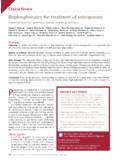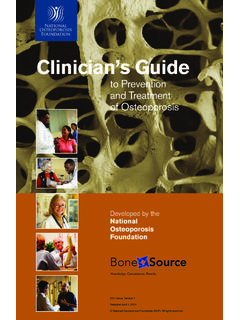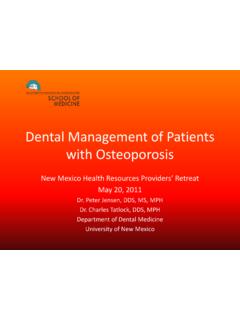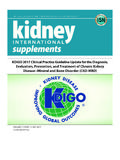Transcription of New approaches to pharmacological treatment of …
1 657 Bulletin of the World Health Organization 2003, 81 (9)IntroductionOsteoporosis is structural failure of the skeleton that causesan increased risk of fracture. Low bone mass and microar-chitectural deterioration of bone tissue increase bone fragili-ty, which means that fractures can occur after low-energytraumas. Such fractures are associated with mortality andwith significant short- and long-term morbidity. The man-agement of osteoporosis must target all aspects of the condi-tion: bone mass should be maximized; fractures should beprevented; and people who have already sustained a fractureshould be rehabilitated to minimize associated pain, limita-tion of activities, and restriction of participation in treatments act on bone and have effects onits mass, strength, and treatments that primarily and effec-tively reduce bone loss and fracture risk have become avail-able in the last few decades.
2 The role of estrogen for mainte-nance of bone integrity was recognized early on, and hor-mone replacement therapy was recommended to preventosteoporosis. Hormone replacement therapy is non-specific,however, and with evidence of its undesirable side-effectsand low compliance rates, the search for more potent andspecific treatments with large effects on bone mass resultedin the development of direct anti-resorptive agents, includ-ing the bisphosphonates and selective estrogen receptormodulators. This paper outlines the underlying bone biology anddescribes the therapies currently used to treat osteoporosis . Italso looks at new approaches to the use of current treatmentsand the development of new agents to prevent developmentof the approaches to pharmacological treatment ofosteoporosisKristina kesson1 AbstractOsteoporosis has been recognized as a major public health problem for less than two decades.
3 The increasing incidenceof fragility fractures, such as vertebral, hip, and wrist fractures, first became apparent from epidemiological studies in the early andmid-1980s, when effective treatment was virtually unavailable. pharmacological therapies that effectively reduce the number offractures by improving bone mass are now available widely in countries around the world. Most current agents inhibit bone lossby reducing bone resorption, but emerging therapies may increase bone mass by directly promoting bone formation as is thecase with parathyroid hormone. Current treatment alternatives include bisphosphonates, calcitonin, and selective estrogen recep-tor modulators, but sufficient calcium and vitamin D are a prerequisite. The availability of evidence-based data that show reduc-tions in the incidence of fractures of 30 50% during treatment has been a major step forward in the pharmacological preventionof fractures.
4 With all agents, fracture reduction is most pronounced for vertebral fracture in high-risk individuals; alendronate andrisedronate also may protect against hip fracture in the elderly. New approaches to pharmacological treatment will include furtherdevelopment of existing drugs, especially with regard to tolerance and frequency of dosing. New avenues for targeting the condi-tion will emerge as our knowledge of the regulatory mechanisms of bone remodelling increases, although issues of tissue speci-ficity may be difficult to solve. In the long term, information gained through knowledge of bone genetics may be used to adaptpharmacological treatments more precisely to each therapy; osteoporosis , Postmenopausal/drug therapy; Fractures/pathology; Osteoclasts/drugeffects/enzymology; Osteoblasts/drug effects; Bone and bones/physiopathology; Calcium, Dietary/therapeutic use; Vitamin D/thera-peutic use; Diphosphonates/therapeutic use; Calcitonin/therapeutic use; Norpregnenes/therapeutic use; Estrogen replacement ther-apy; Parathyroid hormones/physiology; Organometallic compounds//therapeutic use (source: MeSH, NLM).
5 Mots cl sOst oporose/chimioth rapie; Ost oporose postm nopause/chimioth rapie; Fracture/anatomie pathologique;Ost oclaste/action des produits chimiques/enzymologie; Ost oblaste/action des produits chimiques; Os/physiopathologie; Calciumalimentaire/usage th rapeutique; Vitamine D/usage th rapeutique; Diphosphonates/usage th rapeutique; Calcitonine/usageth rapeutique; Norpr gn nes/usage th rapeutique; Oestrog noth rapie substitutive; Hormones parathyro diennes/physiologie;Organom talliques, Compos s/usage th rapeutique (source: MeSH, INSERM).Palabras claveOsteoporosis/quimioterapia; osteoporosis postmenop usica/quimioterapia; Fracturas/patolog a; Osteoclastos/efectos de drogas; Osteoblastos/efectos de drogas/enzimolog a; Calcio en la dieta/uso terap utico; Vitamina D/uso terap utico;Huesos/fisiopatolog a; Difosfonatos/uso terap utico; Calcitonina/uso terap utico; Norpregnenos/uso terap utico; Terapia de reem-plazo de estr geno; Hormonas paratiro deas/fisiolog a; Compuestos organometalicos/uso terap utico (fuente: DeCS, BIREME).
6 Bulletin of the World Health Organization 2003;81 page 662 le r sum en fran ais. En la p gina 662 figura un resumen en espa Professor, University of Lund, and Department of Orthopaedics, Malm University Hospital, S-205 02 Malm , Sweden (email: activation is not understood. After activation, osteo-clasts cause a local decrease in pH, which precipitates the dis-solution of mineral. Exposure of the matrix permits enzymat-ic degradation of the collagenous structure. The signalsresponsible for termination of bone resorption and initiationof bone formation (coupling) are not well understood; how-ever, evidence suggests that the liberation of components ofthe matrix-embedded, insulin-like growth factor (IGF) sys-tem IGF-I, IGF-II, and their binding proteins mayinduce this shift (2). Other putative coupling factors includecytokines, of which the interleukins IL-1, IL-6, IL-11, trans-forming growth factor- , and tumour necrosis factor- seemto be involved most closely in the regulation of bone coupling between resorption and formation is neededto maintain bone mass and preserve the structural integrity ofthe bone.)
7 Incomplete filling of resorptive cavities results inthe net loss of bone that is characteristic of treatment In general, pharmacological agents either decrease boneresorption to produce secondary gains in bone mass or areanabolic and produce direct increases in bone mass. Ideally,such drugs also should increase bone strength and bonequality. As the turnover of bone is slow, the time betweenstarting treatment and assessing its effect on bone mass orfracture takes several years. Because this makes it difficult toshow the effect of treatments on the dichotomous anduncommon key outcome of fracture, the continuous vari-able bone mass is often used as a surrogate measure. Anincreasing number of randomized controlled trials of severalanti-osteoporotic drugs have fracture as an endpoint,however, and show reductions in the incidence of fractureswithin 1 3 addition to estrogen, drugs with specific anti-resorp-tive actions are available for the treatment of osteoporosis ,including bisphosphonates, calcitonin, and selective estro-gen receptor modulators.
8 Furthermore, calcium and vitaminD act on bone by decreasing resorption, while calcium alsois regarded as an essential building block for bone. 658 Special Theme Bone and Joint Decade 2000 2010 Bulletin of the World Health Organization 2003, 81 (9)Risk factors for osteoporosis and fractureLow bone mass is a major independent risk factor forfracture, along with a number of other risk factors (ofvariable importance) that relate to the impact and frequencyof trauma and to protective mechanisms. It is essential torecognize that the risk factors for developing osteoporosis , low bone mass, and the risk factors for sustaining afracture are not identical, but that bone fragility is a veryimportant factor that enhances the risk of fracture after lowenergy trauma. The etiology of idiopathic osteoporosis issimilarly multifactorial: apart from its relation with age andsex, it also is related strongly to genetic and environmentalfactors.
9 As a person ages, resorbed bone is replaced incom-pletely, which leads to a net loss of bone; osteoporosis isdefined as a bone mineral density that is standarddeviations less than the mean value for young adults (1).Probably the two most important ways to maintain a bonemass above a dangerous fracture threshold are to attain ahigh peak bone mass in young adulthood and to have a lowrate of loss during ageing. Bone biology systemic and local regulation ofbone turnoverCurrent pharmacological treatments for osteoporosis weredeveloped on the basis of existing knowledge of basic bonebiology, while the development of novel therapies will relyon the exploration of fundamental regulatory balance between bone resorption and bone formation ismaintained through a complex regulatory system of systemicand local factors that act on bone cells, such as calcium-reg-ulating hormones, sex hormones, growth factors, andcytokines (Table 1).
10 The competence of bone cells and thenumber of active cells determines the production of bonematrix proteins, while other incompletely understood intrin-sic mechanisms determine mineralization and microstruc-ture formation. Resorption of bone at a specific site may be induced bymicrodamage, but the initiating event in the process of osteo-Polypeptide hormonesPolypeptide growth factorsParathyroid hormoneInsulin-like growth factorCalcitoninTransforming growth factor- family of peptides (bone morphogenic proteins, inhibins, activins)InsulinFibroblast growth factors Growth hormonePlatelet-derived growth factorSteroid hormonesCytokines from the immune and haematological system1,25-dihydroxyvitamin D3 Tumour necrosis factor (osteoclast-differentiating factor, receptor activator of nuclear factor B ligand,osteoprotegerin)
















